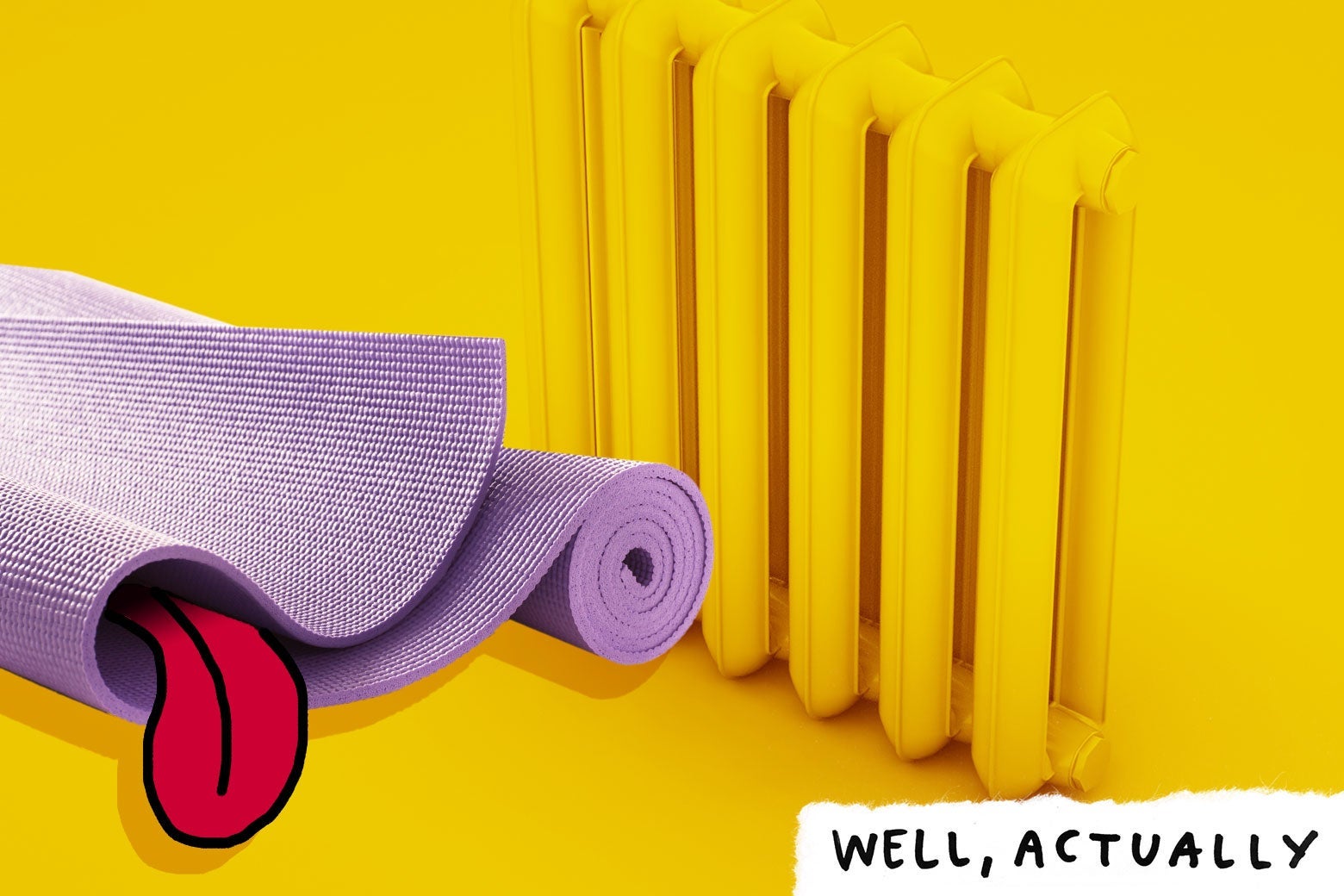
As the temperature drops and the stress of school, darkness, and squeezing back into fall jeans closes in upon us, I’ve been on a streak of showing up to a very (very) warm room to do yoga. It is calming, and exceedingly pleasant. And it has me wondering: Why did we start doing yoga in a hot room? Is this a wellness trend on the level of, say, Peloton or working out in a cold room, that is expensive and gimmicky but perhaps worth embracing nonetheless? Or is the “hot” in hot yoga actually doing something for you?
Hot yoga was invented by Bikram Choudhury, a man from Kolkata, India, with a directive to spread yoga throughout the world and a distaste for shivery rooms. He opened up a studio in San Francisco in the ‘70s, made his name synonymous with the exercise, and gathered followers from Lady Gaga to George Clooney, according to a 2011 GQ profile that dubbed his “cult” both “overheated” and “oversexed.” With a penchant for yelling things like “Miss Teeny Weeny Bikini” (and more explicit) to address students, Clancy Martin writes, Choudhury’s persona made some sense for popularizing his take on yoga in America, where we love a personality shouting at us to move in a certain way.
Choudhury has been embroiled in scandal since allegedly raping a student, and then in turn allegedly harassing his former attorney for trying to look into it (the attorney was awarded $7 million; Bikram has since decamped to Acapulco, Mexico—where he still teaches, according to HuffPost). But there are even more reasons to be frustrated with Bikram yoga besides its founder’s misdeeds: Classes are 90 minutes, they consist of the same tiresome sequence of poses, the room must be outfitted in a specific way. “We refused to put carpet down,” says Ted Grand, who co-owned a couple of Bikram studios in Toronto. “It got us in a lot of trouble.”
Tired of feeling “demonized” by a strict set of brand expectations, he and his business partner Jessica Robertson shed the Bikram name and founded Modo yoga in 2004. One thing they kept was the Bikram method’s call for a hot room—though they did their classes in a slightly less hot room (Bikram calls for 105 degrees Fahrenheit). They also integrated different poses and allowed some classes to be donation-based. By Grand’s estimation, they were the first hot yoga studio that wasn’t under the Bikram brand. Today, they have 75 studios all over the world. (A point of pride: Their first studio in the United States was in north Kentucky because that’s where a teacher who wanted to open one happened to live.) Other hot yoga studios have defected, too, with Manhattan’s first Bikram studio changing its focus and name in 2017 after Choudhury was ordered to pay the $7 million. These days, there are plenty of places to seek out hot yoga divorced from Bikram, including those at the luxury gym Equinox, which has helped slot hot yoga into the world of branded boutique workout classes geared toward rich people.
This turn, for yoga to become an exclusive activity, goes hand in hand with the cultural appropriation of the 2,500-year-old spiritual practice, as yoga teacher and researcher Rina Deshpande explains in Self. “Yoga, a practice based in large part on self-awareness, self-love, and freedom from material trappings, is now mostly depicted with stylish athletic apparel and spun toward white populations.”
Another part of the problem, Deshpande wrote, is that yoga is often understood as a physical activity, which is far from how it started. Yoga teacher Vikram Jeet Singh, grew up in Dehli, India, where “you would go to the park, there would be groups of people practicing yoga there,” he says. “Yoga is breathwork, community-oriented.” It was in the West that yoga “meant movement.” Singh started doing yoga himself in 2006, when he was living in Canada, working at a corporate job, and his then-boss suggested it. After signing up for an intro week of unlimited classes for about $20 (a common deal at yoga studios, and a great thing to take advantage of), he was hooked, eventually training to become a teacher. And even though it looks different than the yoga he saw growing up, he explains how movement can still support yoga as a larger way of existing in the world: “To me, the focus of your physical asana”—or posture—“is to keep your body healthy, and then in space you’re creating, you’re hoping to find some clarity of your mind.” Still, told me he wishes people focused more on the aspects of yoga outside of movements and how well they’re doing them. “There’s better workouts than what can you get in a yoga class,” he adds.
That’s true for even hot yoga, for all its excessive, un-ignorable sweating. As yoga booms in popularity—it’s now a $16 billion industry—researchers like Rachael Nelson at Central Michigan University are working to figure out how the practice fits into the larger world of exercise so that doctors and guidelines can recommend it appropriately. She and her colleagues had 14 participants complete short yoga classes in a hot room, and in a regular room. While heart rate and perceived exertion went up during the hot class, the actual intensity (as measure by a standard called maximal oxygen consumption) wasn’t notably different. Yoga, hot or not, is low-intensity in terms of a workout. That uptick in heart rate in hot yoga comes from your body shifting blood around to keep its core temperature stable (and cool enough). Nelson and colleagues are also working on a larger study to confirm these results.
